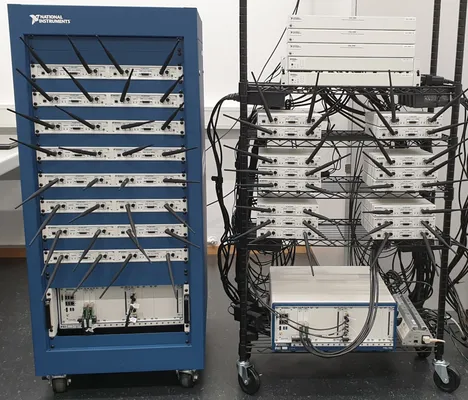Massive Multiple-Input Multiple-Output Systems

Increasing demands regarding high data rates, low latency, and high link reliability in new generation networks require disruptive solutions to cope with the associated challenges. Taking advantage of spatial diversity in multiantenna techniques is one solution that has shown promising results.
Communication systems with multiple antennas at both the transmitter and the receiver, are commonly known as multiple-input multiple-output (MIMO) systems, where according to the number of mobile stations taken into account when multiplexing spatial layers, we can differentiate between single-user MIMO (SU-MIMO) and multiple-user MIMO (MU-MIMO) systems. Further, theoretical results have shown that some of the negative effects associated with fast fading, noise, interference, hardware impairments and precoding complexity diminish when scaling up the number of antennas at the base station in comparison to the number of mobile stations, vanishing in the asymptotic case. This has been termed "massive MIMO".
Given the high complexity involved in constructing such systems, however, experimental demonstrations are still scarce within the scientific community. The ACES Lab joins these research efforts with a proof-of-concept 32x32 MIMO-OFDM system based on reprogrammable software-defined radios. Our FPGA-based MIMO prototyping system operates in a either SU- or MU-MIMO configuration using time division duplex (TDD), thus taking advantage of the uplink-downlink channel reciprocity in order to carry out a reliable channel estimation to obtain accurate channel state information (CSI). Building upon the NI MIMO Application Framework, with modulation schemes ranging from 4-QAM to 256-QAM we obtained a combined throughput above 300 Mbps with an end-to-end delay of 11 ms.
We are investigating the following areas:
- Single carrier transmission MIMO systems
- Realization of ultra-reliable low latency communications over MIMO channels
- Performance evaluation of error correction codes in massive MIMO-OFDM systems
- Single- and multiple-user massive MIMO Systems
- Integration of physical layer security and identification approaches in MIMO systems
- Achieving improved ergodic spectral efficiency in MIMO channels
- Implementation of massive MIMO operating with frequency division duplex (FDD)